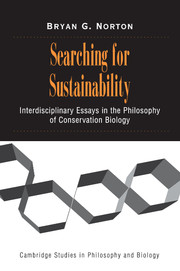Book contents
- Frontmatter
- Contents
- Searching for Sustainability
- General Introduction: An Interdisciplinary Experiment
- I PRAGMATISM AS AN ENVIRONMENTAL PHILOSOPHY
- II SCIENCE, POLICY, AND POLICY SCIENCE
- III ECONOMICS AND ENVIRONMENTAL SUSTAINABILITY
- IV SCALING SUSTAINABILITY: ECOLOGY AS IF HUMANS MATTERED
- V SOME ELEMENTS OF A PHILOSOPHY OF SUSTAINABLE LIVING
- VI VALUING SUSTAINABILITY: TOWARD A MORE COMPREHENSIVE APPROACH TO ENVIRONMENTAL EVALUATION
- Index
II - SCIENCE, POLICY, AND POLICY SCIENCE
Published online by Cambridge University Press: 21 January 2010
- Frontmatter
- Contents
- Searching for Sustainability
- General Introduction: An Interdisciplinary Experiment
- I PRAGMATISM AS AN ENVIRONMENTAL PHILOSOPHY
- II SCIENCE, POLICY, AND POLICY SCIENCE
- III ECONOMICS AND ENVIRONMENTAL SUSTAINABILITY
- IV SCALING SUSTAINABILITY: ECOLOGY AS IF HUMANS MATTERED
- V SOME ELEMENTS OF A PHILOSOPHY OF SUSTAINABLE LIVING
- VI VALUING SUSTAINABILITY: TOWARD A MORE COMPREHENSIVE APPROACH TO ENVIRONMENTAL EVALUATION
- Index
Summary
My location in a school of public policy has the advantage that I, my colleagues, and my students are constantly dealing in practical case studies, in which scientists from multiple fields provide data and projections, and in which a problematic situation must be addressed, given imperfect science and in the face of serious disagreements among interest groups. I have learned that one of the most important areas in which philosophers can make a real difference is in understanding the complex role of science in policy processes. My involvement with the EPA illustrated how the anachronistic insistence on a sharp separation of science and value can skew the entire policy process. Insisting that “risk analysis” could be a pure science and that valuation, judgment, and decision making could be compartmentalized as “risk management,” practitioners of risk analysis and EPA managers engaged in a charade that served their shared purposes. They were able to claim that agency decisions could be based on quantified, value-neutral data, provided that the politicians and social values are removed from the process, and provided that the scientists are well funded to do quantified analyses of “risk factors.” In this way, the commitment to value-neutral science provided something for both scientists and bureaucrats. This charade, however comforting to scientists – who could eschew politics – and to decision makers – who could claim that their decisions were implied by quantified scientific models – rendered the EPA ineffectual.
- Type
- Chapter
- Information
- Searching for SustainabilityInterdisciplinary Essays in the Philosophy of Conservation Biology, pp. 105 - 106Publisher: Cambridge University PressPrint publication year: 2002



